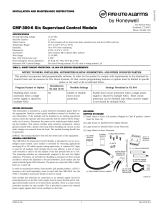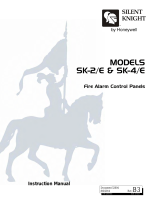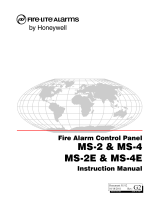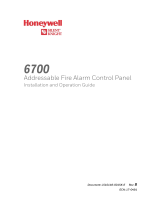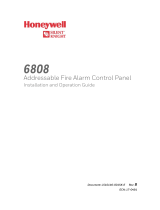Page is loading ...

INSTALLATION AND MAINTENANCE INSTRUCTIONS
SYNC-1 Accessory Card
Compatible Devices:
Notification Appliances: H12/24, H12/24K, HC12/24, S12XX, S24XX, SC24XX, P12XX,
P24XX, PC24XX, SP2C24XX, SP2424XX, SP2W24XX, DS2475XXX,S1224MC, S1224MCW,
SP2R1224MC, SP2W1224MC, P1224MC-Series, P1224MCW, S1224MC-Series, CH24MC,
CH24MCW, SP3R1224MC, SP3R1224MCW, SP2R1224MCK, P2RX, P2WX, P4RX, P4WX,
SRX, SWX, SCRX, SCWX, HRX, HWX, CHX, CHRX, CHWX, CHSRX, CHSWX, PC2RX,
PC2WX, PC4RX, PC4WX, H12/24X, PA400X, S1224MCX, SC24XX, SP2R1224MCX,
SP2W1224MCX, CH24MCX, MHR(A), MHW(A), MHRZA, MHWZA, SPSX, SPSCX,
B200S, B200SR
Add suffix “W” for white models
Control Modules: Used with a UL listed Six Supervised Control Module.
Control Panels: Refer to six supervised control module installation manual for list.
Power Supplies: Use any regulated power supply that is UL 1481 listed. Any UL 864 listed power supply may also be used, but it must be intended for use with NAC devices.
SPECIFICATIONS
Standby Current
(+0 position): 15mA
(+2 or +4 position, if connected to supply): 2.5mA
Operating Temperature: 32ºF to 120ºF (0ºC to 49ºC)
Wire Gauge: 12-18 AWG
Included: (2) shunts, (4) screws, (2) standoffs
Maximum Loop Power Supply Current Rating
(Class A / Style Z): 2A (See NOTE 1)
(Class B / Style Y): 3A per pair (See NOTE 1)
Power Supply Voltage Range: Refer to compatible power supply installation manual
Maximum Load on a Loop
(Class A / Style Z ): (See NOTE 1)
(Class B / Style Y ): (See NOTE 1)
(maximum alarm current = maximum load on a loop, both cases)
NOTE 1: Refer to installation manual to determine the number of compatible notification appliances, their voltage requirements, current requirements, and wire size. The sum
of the inrush currents, of all the notification appliances connected to a loop, must be equal or less than the Loop Power Supply Current Rating.
Six Supervised
Control Module
SYNC-1
UNUSED
UNUSED
TEMPORAL
UNUSED
C0126-00
FIGURE 1: INSTALLATION OF SYNC-1
GENERAL DESCRIPTION
The SYNC-1 Accessory Card is designed to operate with the Six Supervised
Control Module. It works with the SpectrAlert series of horns, strobes, and
horn/strobes to provide a means of synchronizing the temporal-coded horns,
synchronizing the one-second flash timing of the strobe, and silencing the
horns of the horn/strobe combination over a two-wire circuit while leaving
the strobes active. Each SYNC-1 Accessory Card consists of three electrically
isolated synchronization circuits. Although they are isolated from each other,
all three circuits are synchronized with respect to each other. A SYNC-1 Ac-
cessory Card enables a Six Supervised Control Module to synchronize a maxi-
mum of three Class A or six Class B notification appliance circuits (NACs).
NOTE: This manual should be left with the owner/user of this equipment.
TEMPORAL CODING ON MA12/24D AND PA400
(NON-SPECTRALERT HORNS)
• Program module to provide temporal coding by inserting jumper on “temporal”
pins on the SYNC-1 board. Do this prior to installing the SYNC-1 Accessory
Card onto the Six Supervised Control Module.
• Connect only sounders producing a continuous tone to the module NAC
output(s).
CAUTION
Strobes are incapable of operation on a temporal tone Notification Appliance Circuit.
INSTALLATION OF SYNC-1 ACCESSORY CARD
Install two screws into the holes on the bottom center of the Six Supervised
Control Module. On the front side of the board, install two standoffs onto
these screws. The SYNC-1 Accessory Card plugs into the pins of the Six Super-
vised Control Module. The pins on the module are labeled “SYNC GENERA-
TOR.” Remove the three large shunts on the Sync Generator pins. Line up the
holes on the accessory card with the pins on Six Supervised Control Module.
CAUTION: Ensure the pins and holes are lined up correctly or the SYNC-1
accessory card will not operate properly. Push down firmly on the accessory
card. Install two screws into standoffs to secure the board.
3825 Ohio Avenue, St. Charles, Illinois 60174
800/736-7672, FAX: 630/377-6495
www.systemsensor.com
I56-2190-006
1 I56-2190-006
03-11

WIRING
When used with the SYNC-1 Accessory Card, the Six Supervised Control Mod-
ule can accommodate a maximum of three power supplies limited to a maxi-
mum of 3 Amp each. The SYNC-1 Accessory Card control circuitry can only
be energized by connecting power supplies to the “PS” terminals at the even
positions (+0, +2, +4) of the Six Supervised Control Module. All power
supply connections must be made at even positions. The master control of
the SYNC-1 Accessory Card is powered by the supply connected to the “PS”
terminals at position (+0). Therefore there must be a supply connected to
(+0) for the SYNC-1 Accessory Card to be operational.
The SYNC-1 Accessory Card used with a Six Supervised Control Module is
limited to a maximum of three power supplies, therefore each circuit pair
(+0/+1, +2/+3, +4/+5) must share a supply in order for all NACs to
be powered. Due to supply sharing the maximum load on a Class A NAC is
limited to 3A while the maximum load on a pair of Class B NACs is limited
to 3A total.
NOTE: Power Supply Monitoring must be disabled (on the Control Module)
when using the SYNC-1 Accessory Card on the Six Supervised Control Module.
Refer to the Six Supervised Control Module installation manual for more detail
regarding its configuration and wiring requirements.
To interconnect SYNC-1 Accessory Cards wire the Slave and Horn connections
as shown in Figure 2. The slave wires will synchronize all NACs correspond-
ing to the interconnected boards. Any SYNC-1 which has no connections to its
slave in terminals will operate as a master. It will generate a signal which will
be duplicated by all interconnected units downstream. The horn wires will
enable horn control on all NACs corresponding to the interconnected boards.
Horn control also requires a silenceable NAC circuits to be wired to the horn
in terminals of the master SYNC-1 Accessory Card as shown in Figure 3.
A maximum of 11 Slaves Sync-1 Cards can be connected to a Master Sync-1
Card, totalling 12.
CAUTION
All horn and slave wiring interconnecting SYNC-1 accessory cards must be con-
tained within the same enclosure. If multiple enclosures are used they must be lo-
cated within 20 feet of each other with all horn and slave wiring between enclosures
routed inside of conduit. This conduit should be grounded metal containing no other
field wiring.
2 I56-2190-006
03-11

BASE ADDRESS
NAC
PS
NAC
PS
—
+
+
—
NAC
PS
—
+
+
—
NAC
PS
—
+
+
—
NAC
TOP
BOT
– +
+ NAC –
– +
– PS +
SLC
PS
—
+
+
—
+1
+2 +3 +4 +5
T11
T10
T0
+0
T12
T1 T2 T3 T4 T5
T13 T14 T15
T16
ENABLE POWER SUPPLY MONITOR
—
+
+
—
0
1
2
3
4
5
6
7
8
9
0
1
2
3
4
5
6
7
8
9
SLAVE IN
HORN IN
—
+
—
+
SLAVE OUT
HORN OUT
—
+
—
+
BASE ADDRESS
NAC
PS
NAC
PS
—
+
+
—
NAC
PS
—
+
+
—
NAC
PS
—
+
+
—
NAC
TOP
BOT
– +
+ NAC –
– +
– PS +
SLC
PS
—
+
+
—
+1
+2 +3 +4 +5
T11
T10
T0
+0
T12
T1 T2 T3 T4 T5
T13 T14 T15
T16
ENABLE POWER SUPPLY MONITOR
—
+
+
—
A/B SELECT
DISABLE 1
DISABLE 2
DISABLE 3
0
1
2
3
4
5
6
7
8
9
0
1
2
3
4
5
6
7
8
9
SLAVE IN
HORN IN
—
+
—
+
SLAVE OUT
HORN OUT
—
+
—
+
DISABLE SHORT CIRCUIT PROTECTION
ENABLE POWER SUPPLY MONITOR
A/B SELECT
DISABLE 1
DISABLE 2
DISABLE 3
DISABLE SHORT CIRCUIT PROTECTION
ENABLE POWER SUPPLY MONITOR
Wiring is
Power Limited
C0123-01
FIGURE 2: CONNECTING TWO SYNC-1 CARDS (CLASS B OPERATION, ONE POWER SUPPLY USED)
SLAVE IN
HORN IN
—
+
—
+
SLAVE OUT
HORN OUT
—
+
—
+
Silenceable NAC Output
Wiring is
Power Limited
To Next SYNC-1 Horn In
C0122-01
FIGURE 3: HORN OPERATION
3 I56-2190-006
03-11

The sounder and/or strobe will not work without power. The sounder/strobe gets its
power from the fire/security panel monitoring the alarm system. If power is cut off for
any reason, the sounder/strobe will not provide the desired audio or visual warning.
The sounder may not be heard. The loudness of the sounder meets (or exceeds) cur
-
rent Underwriters Laboratories’ standards. However, the sounder may not alert a sound
sleeper or one who has recently used drugs or has been drinking alcoholic beverages. The
sounder may not be heard if it is placed on a different floor from the person in hazard or
if placed too far away to be heard over the ambient noise such as traffic, air conditioners,
machinery or music appliances that may prevent alert persons from hearing the alarm.
The sounder may not be heard by persons who are hearing impaired.
NOTE: Strobes must be powered continuously for sounder operation.
The signal strobe may not be seen. The electronic visual warning signal uses an ex-
tremely reliable xenon flash tube. It flashes at least once every second. The strobe must
not be installed in direct sunlight or areas of high light intensity (over 60 foot candles)
where the visual flash might be disregarded or not seen. The strobe may not be seen by
the visually impaired.
The signal strobe may cause seizures. Individuals who have positive photoic response
to visual stimuli with seizures, such as persons with epilepsy, should avoid prolonged
exposure to environments in which strobe signals, including this strobe, are activated.
The signal strobe cannot operate from coded power supplies. Coded power supplies pro
-
duce interrupted power. The strobe must have an uninterrupted source of power in order
to operate correctly. System Sensor recommends that the horn and signal strobe always
be used in combination so that the risks from any of the above limitations are minimized.
WARNING
THE LIMITATIONS OF SOUNDER/STROBES
THREE-YEAR LIMITED WARRANTY
System Sensor warrants its enclosed product to be free from defects in materials and
workmanship under normal use and service for a period of three years from date of
manufacture. System Sensor makes no other express warranty for the enclosed product.
No agent, representative, dealer, or employee of the Company has the authority to in
-
crease or alter the obligations or limitations of this Warranty. The Company’s obligation
of this Warranty shall be limited to the replacement of any part of the product which is
found to be defective in materials or workmanship under normal use and service during
the three year period commencing with the date of manufacture. After phoning System
Sensor’s toll free number 800-SENSOR2 (736-7672) for a Return Authorization number,
send defective units postage prepaid to: Honeywell, 12220 Rojas Drive, Suite 700, El Paso
TX 79936 USA. Please include a note describing the malfunction and suspected cause of
failure. The Company shall not be obligated to replace units which are found to be defec
-
tive because of damage, unreasonable use, modifications, or alterations occurring after
the date of manufacture. In no case shall the Company be liable for any consequential
or incidental damages for breach of this or any other Warranty, expressed or implied
whatsoever, even if the loss or damage is caused by the Company’s negligence or fault.
Some states do not allow the exclusion or limitation of incidental or consequential dam
-
ages, so the above limitation or exclusion may not apply to you. This Warranty gives you
specific legal rights, and you may also have other rights which vary from state to state.
4 I56-2190-006
©2016 System Sensor. 03-11
/
